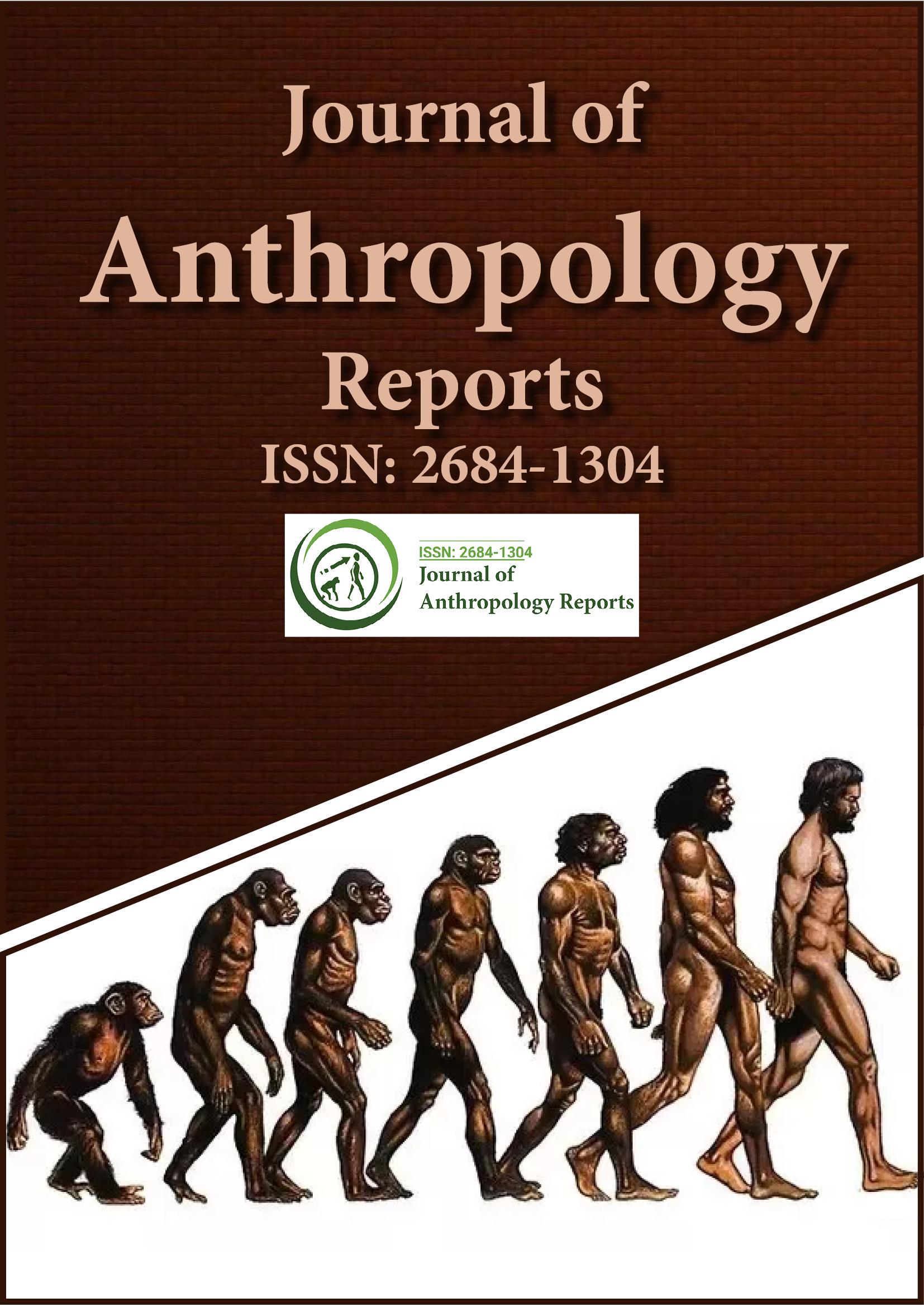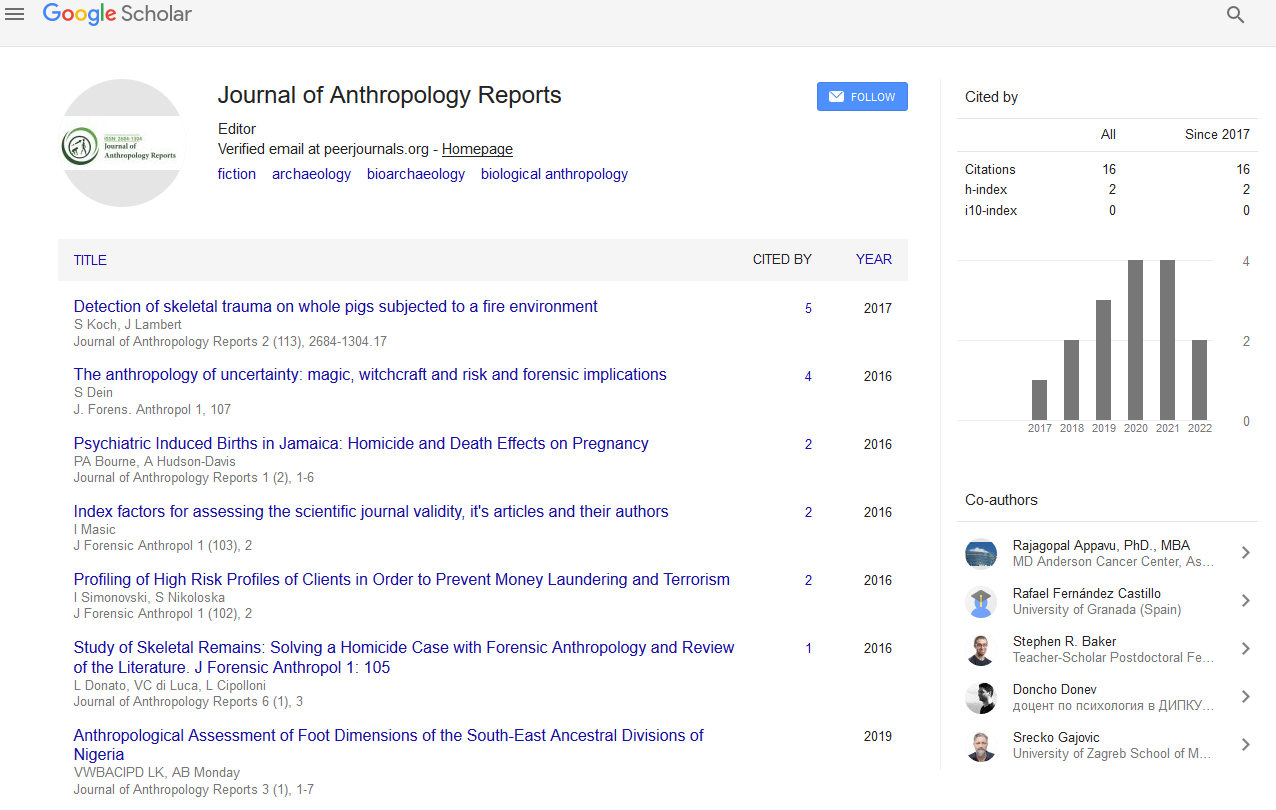Indexed In
- RefSeek
- Hamdard University
- EBSCO A-Z
Useful Links
Share This Page
Journal Flyer

Open Access Journals
- Agri and Aquaculture
- Biochemistry
- Bioinformatics & Systems Biology
- Business & Management
- Chemistry
- Clinical Sciences
- Engineering
- Food & Nutrition
- General Science
- Genetics & Molecular Biology
- Immunology & Microbiology
- Medical Sciences
- Neuroscience & Psychology
- Nursing & Health Care
- Pharmaceutical Sciences
Commentary Article - (2024) Volume 7, Issue 2
Importance of Forensic Anthropology in Estimating Ancestry
Kyota Sumo*Received: 27-May-2024, Manuscript No. JFA-24-26528; Editor assigned: 30-May-2024, Pre QC No. JFA-24-26528 (PQ); Reviewed: 13-Jun-2024, QC No. JFA-24-26528 (QC); Revised: 20-Jun-2024, Manuscript No. JFA-24-26528 (R); Published: 27-Jun-2024, DOI: 10.35248/2684-1304.24.7.193
Description
To estimate the age of a person at the hour of their demise, scientific anthropologists concentrate on the turn of events and uprightness of their teeth and bones. Teeth fill in an anticipated succession, and the phase of tooth emission, root development, and the presence of extremely durable teeth can give important age gauges. Furthermore, as people progress in years, their teeth give indications of whittling down (or mileage) and loss of veneer. Criminological anthropologists can likewise quantify a singular's bone thickness and dissect the construction and presence of their bones, which change with age. To appraise height (how tall an individual was at the hour of their passing) criminological anthropologists commonly measure the length of long bones, like the femur or tibia in the legs. They then, at that point, substitute these estimations into a numerical condition to foresee an individual's level. For sex assessment, scientific anthropologists investigate the pelvis. A pelvis that has a more extensive, unhindered birth waterway and a round pubic curve is regularly classified as female. Then again, a pelvis that is smaller with a more calculated pubic curve is ordinarily sorted as male. This strategy for sex assessment, be that as it may, is a long way from an ideal science. A wide range of genotypes and aggregates comprise a person's natural sex, which measurable anthropologists can't recognize from the pelvis alone. It likewise doesn't represent individuals who are conceived intersex.
Notwithstanding, criminological anthropologists utilize this strategy to gauge a natural sex classification that might assist with recognizing a departed person. Significantly, this cycle ought to never be compared with assessing an individual's orientation or orientation character. In scientific settings, anthropologists frequently use family line as an intermediary for assessing an individual's race or identity regardless of each of the three terms having totally different social implications. In spite of the contrasting implications of these terms, the objective of heritage assessment is to give a racial or ethnic characterization that lines up with how the individual would have been seen when they were alive. Lineage assessment is the most challenged part of the natural profile. Its strategies are as yet affected by the racial characterizations of the late nineteenth and mid twentieth hundreds of years, which researchers have since perceived as pseudoscientific. For instance, anthropologists felt that different highlights of the skull, including its general size, shape, nasal opening, and facial qualities (like the shape and size of eye attachments, nasal extension, jaw, and cheekbones), demonstrated the landmass an individual started from. They utilized these highlights to encourage cranial files, which are numerical proportions or estimations that arranged skulls into various racial or ethnic gatherings. For instance, the cephalic record, which estimates the width-to-length proportion of the skull is utilized to sort skulls into dolichocephalic (long-headed), mesocephalic (medium-headed), or brachycephalic (shortheaded) gatherings, with these gatherings remembered to have a relationship to hereditary foundations. In any case, propels in transformative science have shown that these lists distort the hereditary variety that we see inside the human species. All in all, the varieties in actual highlights between people or populaces don't flawlessly squeeze into expansive familial classes like African, Asian, or European (Likewise, it is as yet normal for measurable anthropologists to utilize their assessment of a singular's family line to characterize them into a racial or ethnic classification. Nonetheless, in light of the fact that race in people is socially characterized, and not natural, it's unrealistic to gauge a singular's race in view of actual attributes, for example, facial or skull highlights. We currently realize that the aggregates saw in individuals named a specific race are fairly impacted by development. As such, any distinctions in facial and skull highlights are because of hereditary changes after some time, related to natural and social impacts.
Conclusion
Numerous anthropologists are requiring the coordination of transformative hypothesis into family line assessment. Transformative hypothesis makes sense of how people and populaces are ceaselessly changing because of their surroundings, for instance through regular determination and hereditary float. It likewise represents verifiable occasions, for example, the transoceanic slave exchange or colonization, which have added to the blending of already separate populaces. These impacts can make sense of why populaces living on a similar mainland might have different actual elements. General classifications, like African or European, don't precisely address these distinctions, and neither do socially characterized racial classes.
Citation: Sumo K (2024) Importance of Forensic Anthropology in Estimating Ancestry. J Anthropol Rep. 7:193.
Copyright: © 2024 Sumo K. This is an open-access article distributed under the terms of the Creative Commons Attribution License, which permits unrestricted use, distribution, and reproduction in any medium, provided the original author and source are credited.

